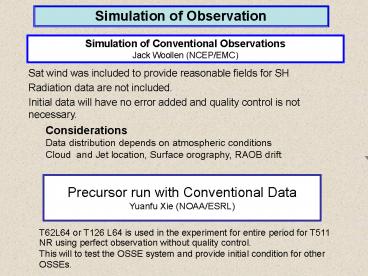Simulation of Observation PowerPoint PPT Presentation
Title: Simulation of Observation
1
Simulation of Observation
Simulation of Conventional ObservationsJack
Woollen (NCEP/EMC)
Sat wind was included to provide reasonable
fields for SH Radiation data are not included.
Initial data will have no error added and
quality control is not necessary.
Considerations Data distribution depends on
atmospheric conditions Cloud and Jet location,
Surface orography, RAOB drift
Precursor run with Conventional DataYuanfu Xie
(NOAA/ESRL)
- T62L64 or T126 L64 is used in the experiment for
entire period for T511 NR using perfect
observation without quality control. - This will to test the OSSE system and provide
initial condition for other OSSEs.
2
Checkout New Conventional Simulated Observations
- Run OSSE assimilation of new conv sim obs from
1may2005 12z - Run free forecast from same IC
- Compare fits of 1) and 2) to the nature run truth
After about a week things looked pretty good!
Global 850mb T fits to NR Free forecast OSSE
conv obs
3
After two weeks it went sideways
4
What happened? Antarctica got very very cold.
850 mb T (nr-osse) plotted
Day 13
Day 15
Day 17
Day 19
!!50 deg differences!!
5
Maybe the observations are incorrectly created
from model level data?
EC 1x1 T 80S section
NC 1x1 T 80S section
Comparison of EC and NC interpolation of t from
the model level data at latitude 80S showed a
systematic difference under the ground
ECNC T 80S section
80S topography
6
Comparing EC(white) NC (green) and ML(red)
profiles at 00E 80S shows NC near surface
interpolation reproduces ML values better (for
data simulation) than the EC method.
7
Resolution of the situation is in progress
Additional developments include
Upgrade the system to use the latest GSI version.
Model overeaction to cold surface data
circumstantially caused by a moisture constraint
parameter. Turning the constraint off avoids the
problem. Need to examine the variational QC
reaction to unrepresentative data. Higher
resolution (t126 vs t62) also seems to avoid the
problem.
8
OBS91L Nature Run Model level profiles for
simulating radiance obs
For development purposes, 91-level ML variables
are processed at NCEP and interpolated to
observational locations with all the information
need to simulate radiance data (OBS91L).
OBS91L made for all foot prints of HIRS, AMSU,
GOES are produced for a few weeks of the T799
period in October 2005 As well as for the month
of May 2005. OBS91L are produced for all
radiance foot prints assimilated in operational
GDAS as recorded in the archived radstat
files. The OBS91L are also available for
development of a Radiative Transfer Model (RTM)
for development of other forward model.
9
Radiance Simulation System for OSSEGMAO, NESDIS,
NCEPTong Zhu, Haibing Sun, Fuzhong
Weng(NOAA/NESDIS)Jack Woollen(NOAA/NCEP)Ron
Errico, Runhua Yang, Emily Liu, Lars Peter
Riishojgaard, Ravi Govindaraju (NASA/GSFC/GMAO)
Other resources and/or advisors David Groff ,
Paul Van Delst (NCEP) Yong Han, Walter Wolf, Cris
Bernet,, Mark Liu, M.-J. Kim, Tom Kleespies,
(NESDIS) Erik Andersson (ECMWF) Roger Saunders
(Met Office)
OBS91L is produced by Jack Woollen at
NCEP NESDIS and NCEP are working on thinned data
to perform precursor run for entire period.
NASA/GMAO is developing best strategies to
simulate and work on more complete foot prints.
This include development of cloud clearing
algorithm. Full resolution data for GOES for
cloudy radiance are also produced by Tong Zhu.
Existing instruments experiments must be
simulated for control and calibration and
development of DAS and RTM Test GOESR,NPOESS, and
other future satellite data
10
Simulation of GOES-R ABI radiances for OSSE Tong
Zhu et al. 5GOESR P1.31 at AMS annual
meeting http//www.emc.ncep.noaa.gov/research/Join
tOSSEs/publications/AMS_Jan2008/Poster-88thAMS2008
-P1.31-OSSEABI.ppt
Simulated from T511 NR. GOES data will be
simulated to investigate its data impact

